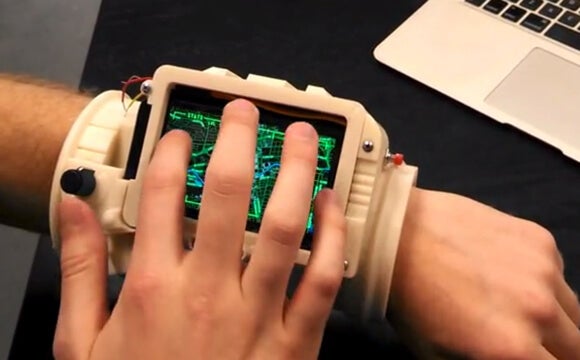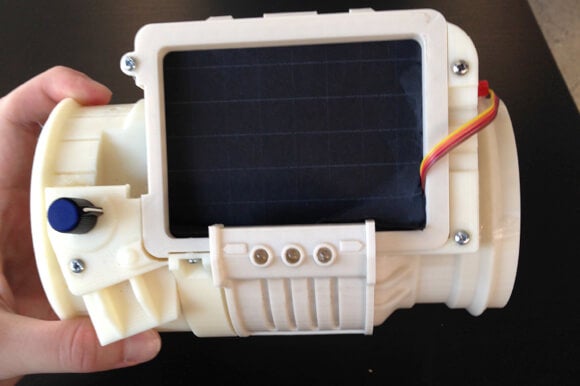Forget smart watches. What you really need is a full-on wrist-computer (3D printed, of course) that looks like it just fell out of a video game—because, basically, it did. A team of hackers from Reno recently developed a working prototype of Fallout’s Pip-Boy 3000 for a NASA contest calling in designs for high-tech space wearables.
The popular Fallout series of video games take place in a post-apocalyptic future where the world’s been decimated by nuclear war. The game’s Pip-Boy 3000 stores and displays maps, stats, inventory, and of course, scans for radiation.
The real-world Pip-Boy 3000—developed by Colin Loretz, Ashley Hennefer, Andrew Warren, Christopher Baker, and Ben Hammel—uses an iOS app that displays maps and a variety of key environmental data like humidity, altitude, latitude and longitude, air pressure, temperature, and yes, radiation levels too.
The team wrote, “The goal was to bring environmental sensors into an easy-to-use cuff device that could help a wearer determine if their environment is safe for navigation or helmet removal.”
The space wearables competition was part of NASA’s larger International Space Apps Challenge 48-hour hackathon. Teams were asked to design a wearable device for explorers in hostile, extraterrestrial environments.
The Pip-Boy 3000 was made from off-the-shelf components including an iPhone 5, a Pinoccio microcontroller (i.e., an affordable mini-computer on a chip), a home-made geiger counter, and a Texas Instruments BLE4 sensor tag.
A Makerbot 3D printer made the device’s enclosure using a design from 3D printing marketplace, Thingiverse. Future capabilities the team hope to add include a heart rate monitor, EEG, and communications—for example, the ability to receive messages, choose from a few simple pre-programmed responses, and reply by merely pushing a button.
In general, we love it. These guys brought a video game device to life. What’s not to like? We do wonder how well bulky gloves would handle the touch interface—perhaps specially designed gloves with rubber, stylus-like tips?
The team’s sci-fi model is part of a long tradition of makers inspired by imaginary technology. Palmer Luckey, inventor of the Oculus Rift, said he was motivated by the immersive virtual reality on display in the sci-fi film The Matrix.
He amassed one of the world’s most extensive collection of virtual reality devices but couldn’t find anything approaching the Matrix-like experience he wanted—so, he decided to build it himself.
Wearable technology has begun to emerge as a fascination in the last few years, if not yet a practical reality. From Google Glass (and a number of emerging competitors) to a selection of smartwatches, tech entrepreneurs and established firms alike are experimenting with prototypes as they seek the perfect package.
So far, none have hit the mark for consumers.
But wrist- or head-mounted displays seem abundantly useful in various specialized settings, where easier access to information is crucial. Such professions might include surgeons, firefighters, police officers, or military personnel. Might we add astronauts and space wearables to the list? Absolutely.
Image Credit: Team Reno/NASA International Space Apps Challenge





